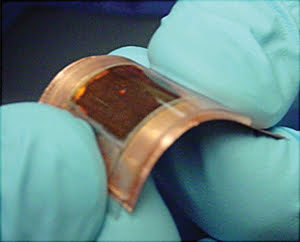Leaves are nature’s quick-change artists. In summer, dressed
in hues of green, they convert sunlight into chlorophyll, take in carbon dioxide
and expel oxygen. Come fall – in northern latitudes, anyway – they turn
from summer’s green to a riot of reds, yellows and oranges.
Researchers at North Carolina State University in Raleigh are
hoping to mimic the chemical magic of leaves with devices they have dubbed “artificial
leaves.” If their concept is successful, it could prove less expensive and
more environmentally friendly than current silicon-based solar cells.
The bendable devices are composed of water-based gel infused with
light-sensitive molecules – the researchers used plant chlorophyll in one
of the experiments – coupled with electrodes coated with carbon materials,
such as carbon nanotubes or graphite.
In the process, two photosensitive ions, DAS— and [Ru(bpy)3]2+,
were used as photoactive molecules embedded in an aqueous gel. The hydrogel photovoltaic
devices showed performance levels comparable with or higher than those of other
biometric or ionic devices, the investigators say.

Shown is a prototype of the flexible hydrogel-based photovoltaic device with an active
area of ~125 mm2. Courtesy of Dr. Orlin Velev, North Carolina State University.
The light-sensitive molecules are excited by the sun’s rays
to produce electricity in a way that is similar to how plant molecules are excited
to synthesize sugars in order to grow, said the university’s Dr. Orlin D.
Velev, Invista professor of chemical and biomolecular engineering and lead author
of a report published online in September 2010 in the Journal of Materials Chemistry.
Velev said the research team hopes to “learn how to mimic
the materials by which nature harnesses solar energy.” Synthetic photosensitive
molecules can be employed here, but naturally derived products such as chlorophyll
also can be integrated easily in these devices because of their water-gel matrix,
he noted.
Commercialization of the artificial leaf device is not the immediate
plan.
“While we are very excited about the biomimetic concept,
we do not look for commercial development of such type of devices at this stage,”
he said. “We foresee two research challenges that have yet to be solved before
larger-scale commercial development.
“First, we still have to improve the efficiency of these
devices, which is … very low. Second, we plan to replicate in such devices
the ability of the natural leaves to regenerate and replace the organic dye, which
will allow us to solve the problems with the long-term stability and performance
that are common for all organic photovoltaic devices. We have clear plans how to
address both of these challenges.”
The investigators are working on fine-tuning the water-based photovoltaic
devices to make them resemble real leaves even more closely.
“The next step is to mimic the self-regenerating mechanisms
found in plants,” Velev said. “The other challenge is to change the
water-based gel and light-sensitive molecules to improve the efficiency of the solar
cells.
“We believe this is one key advance that will be needed
for the future development of usable biomimetic devices due to the photodegradation
of the organic compounds in the devices. Note that natural leaves are a subject
of continuous regeneration. We have a working plan on how to approach this problem,
and we hope to reveal its results in the future.”
He said that someday roofs could be covered with soft sheets of
similar electricity-generating artificial-leaf solar cells. He and his team believe
that, over time, such devices could be made less expensively and on a larger scale
than silicon cells. Plus, they are more environmentally friendly and easy to dispose
of at the end of their life cycle.
“We do not want to overpromise at this stage, as the devices
are still of relatively low efficiency and there is a long way to go before this
can become a practical technology,” Velev said. “However, we believe
that the concept of biologically inspired ‘soft’ devices for generating
electricity may in the future provide an alternative for the present-day solid-state
technologies.”